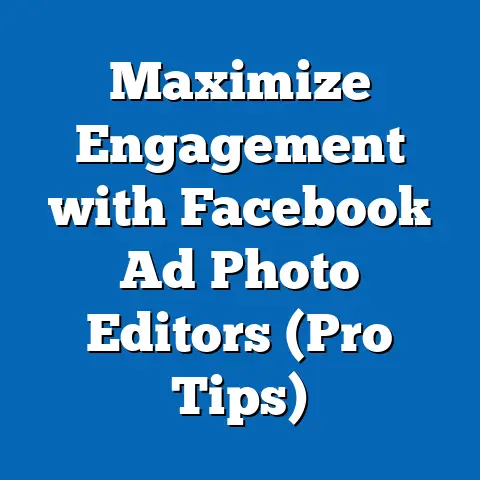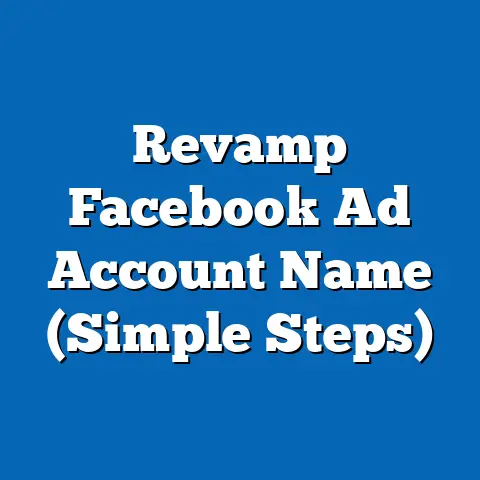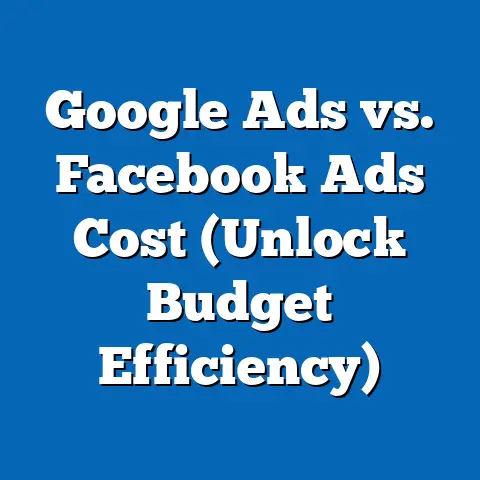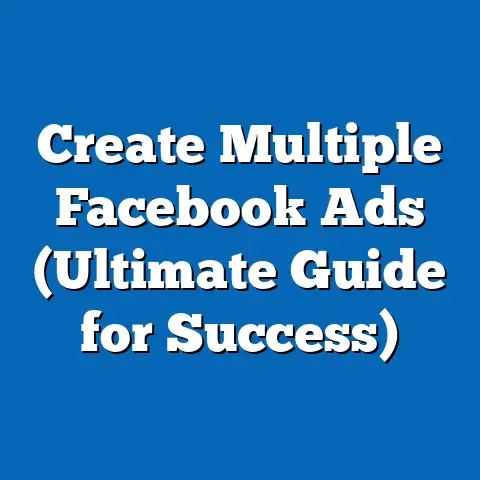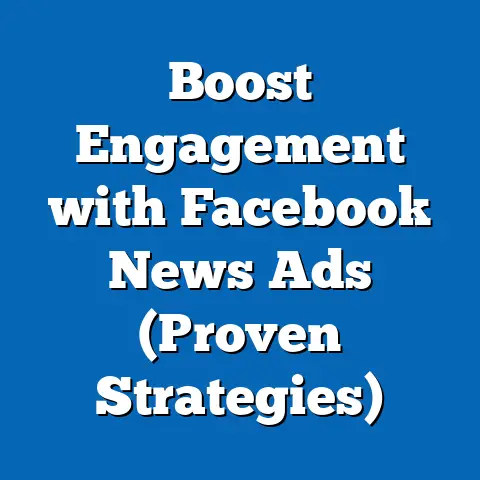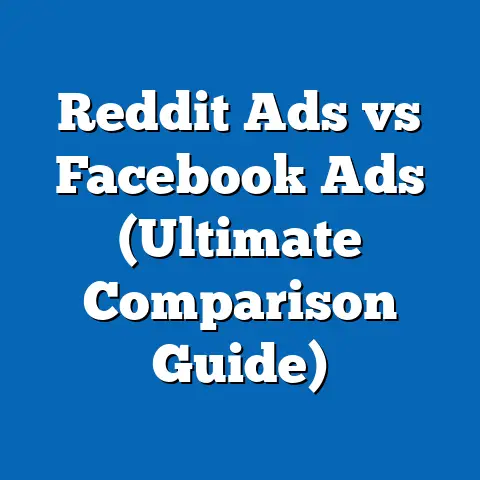Knowing When to Kill Facebook Ad (Smart Strategy)
I remember the first time I launched a Facebook ad campaign for a small, local bakery. We had spent weeks crafting the perfect images of their signature cupcakes, writing mouth-watering copy, and meticulously targeting the right audience. The excitement was palpable. We envisioned lines out the door, a social media frenzy, and a huge boost in sales. I could almost smell the sweet aroma of success!
Then came the waiting game. The initial clicks and likes gave us a rush of adrenaline. “It’s working!” we exclaimed. But as days turned into weeks, the engagement plateaued. The cost per click (CPC) started creeping up, and the conversion rate remained stubbornly low. The initial euphoria slowly morphed into anxiety, then frustration. I felt like I was watching a plant wither despite my best efforts to nurture it.
The hardest part? Admitting that it wasn’t working. We had poured our hearts and souls into this campaign. We believed in the product, the messaging, and the strategy. Pulling the plug felt like admitting defeat, a personal failure. But I knew, deep down, that continuing to throw money at a failing campaign would be a far greater disservice to the bakery and my own reputation. It’s a scenario I’ve witnessed, and experienced, countless times. The struggle between the emotional attachment to a creative concept and the cold, hard need for results is a constant battle for any marketer.
This article is about that battle. It’s about understanding when to make the tough decision to kill a Facebook ad campaign, a decision that can feel like a loss but is ultimately crucial for the health of your business. It’s about learning to separate emotion from data, and using that data to make smart, strategic choices. So, let’s dive into the world of Facebook ads and navigate the tricky terrain of knowing when to say goodbye.
The Importance of Analyzing Performance Metrics
To make informed decisions about your Facebook ad campaigns, you need to become fluent in the language of performance metrics. These numbers aren’t just abstract figures; they’re a direct reflection of how your audience is responding to your message. They tell a story about what’s working, what’s not, and where you need to make changes. Ignoring them is like driving with your eyes closed – you might get lucky for a while, but eventually, you’re going to crash.
Here are some of the key performance indicators (KPIs) that I religiously track:
-
Click-Through Rate (CTR): This is the percentage of people who see your ad and actually click on it. A high CTR indicates that your ad is relevant and engaging to your target audience. Generally, a good CTR is considered to be around 1% or higher, but this can vary depending on your industry and ad objective.
-
Conversion Rate: This is the percentage of people who click on your ad and then complete a desired action, such as making a purchase, filling out a form, or subscribing to a newsletter. A high conversion rate means that your landing page is effective and your offer is compelling. What’s a “good” conversion rate? It depends! But aiming for 2-5% is a solid starting point.
-
Cost Per Click (CPC): This is the amount you pay each time someone clicks on your ad. A high CPC can quickly eat into your budget, so it’s important to keep it as low as possible while still maintaining a good CTR and conversion rate.
-
Cost Per Acquisition (CPA): This is the total cost of acquiring a customer through your ad campaign. It takes into account all of your advertising expenses, including ad spend, creative costs, and management fees. Your CPA should be lower than the average lifetime value of a customer to ensure profitability.
-
Return on Ad Spend (ROAS): This is the amount of revenue you generate for every dollar you spend on advertising. A high ROAS indicates that your ad campaign is highly profitable. Ideally, you want a ROAS of at least 3:1, meaning you’re generating $3 in revenue for every $1 you spend.
-
Frequency: This metric tells you how many times, on average, a person in your target audience has seen your ad. A high frequency can lead to ad fatigue, where people become annoyed by seeing the same ad over and over again, and your performance starts to decline.
-
Relevance Score: While Facebook deprecated this metric, it’s worth understanding the concept. It was a score from 1 to 10 that estimated how relevant your ad was to your target audience. A high relevance score meant that your ad was resonating with your audience and was likely to perform well.
Click-Through Rate (CTR): This is the percentage of people who see your ad and actually click on it. A high CTR indicates that your ad is relevant and engaging to your target audience. Generally, a good CTR is considered to be around 1% or higher, but this can vary depending on your industry and ad objective.
Conversion Rate: This is the percentage of people who click on your ad and then complete a desired action, such as making a purchase, filling out a form, or subscribing to a newsletter. A high conversion rate means that your landing page is effective and your offer is compelling. What’s a “good” conversion rate? It depends! But aiming for 2-5% is a solid starting point.
Cost Per Click (CPC): This is the amount you pay each time someone clicks on your ad. A high CPC can quickly eat into your budget, so it’s important to keep it as low as possible while still maintaining a good CTR and conversion rate.
Cost Per Acquisition (CPA): This is the total cost of acquiring a customer through your ad campaign. It takes into account all of your advertising expenses, including ad spend, creative costs, and management fees. Your CPA should be lower than the average lifetime value of a customer to ensure profitability.
Return on Ad Spend (ROAS): This is the amount of revenue you generate for every dollar you spend on advertising. A high ROAS indicates that your ad campaign is highly profitable. Ideally, you want a ROAS of at least 3:1, meaning you’re generating $3 in revenue for every $1 you spend.
Frequency: This metric tells you how many times, on average, a person in your target audience has seen your ad. A high frequency can lead to ad fatigue, where people become annoyed by seeing the same ad over and over again, and your performance starts to decline.
Relevance Score: While Facebook deprecated this metric, it’s worth understanding the concept. It was a score from 1 to 10 that estimated how relevant your ad was to your target audience. A high relevance score meant that your ad was resonating with your audience and was likely to perform well.
These metrics provide a window into the effectiveness of your ad campaigns. But it’s important to remember that they’re just numbers. They don’t tell the whole story. You also need to consider the emotional context behind the data.
I’ve seen businesses get so caught up in the numbers that they lose sight of the human element. They become afraid to experiment, to take risks, to try new things. They become paralyzed by the fear of failure.
For example, I once worked with a client who was obsessed with keeping their CPC as low as possible. They were constantly tweaking their targeting and bidding strategies, but they were neglecting their ad creative. As a result, their CTR and conversion rate were abysmal. They were saving money on clicks, but they weren’t generating any sales.
It took a lot of convincing, but I finally persuaded them to invest in better ad creative. We hired a professional photographer to take stunning photos of their products and we rewrote their ad copy to be more compelling and persuasive. The result? Their CPC went up slightly, but their CTR and conversion rate skyrocketed. They ended up generating significantly more sales and their overall ROAS improved dramatically.
The lesson here is that you can’t just focus on one metric in isolation. You need to look at the big picture and consider how all of the different metrics interact with each other. And you need to be willing to invest in quality ad creative, even if it means paying a little more per click.
Takeaway: Mastering the language of performance metrics is essential for making informed decisions about your Facebook ad campaigns. But don’t let the numbers paralyze you. Remember to consider the emotional context behind the data and be willing to invest in quality ad creative.
Recognizing the Signs of Underperformance
So, you’re tracking your KPIs, but how do you know when it’s time to pull the plug? What are the specific indicators that suggest an ad campaign is underperforming?
Here are some red flags that I watch out for:
-
Stagnant Engagement Rates: If your likes, comments, and shares have plateaued, it’s a sign that your audience is losing interest in your ad. This could be due to ad fatigue, irrelevant messaging, or a poorly targeted audience.
-
High CPC with Low Conversions: If you’re paying a lot for clicks but not generating any sales, it’s a clear sign that something is wrong. This could be due to a disconnect between your ad and your landing page, a confusing or unpersuasive offer, or technical issues with your website.
-
Low Relevance Score (if you can still access it): A low relevance score indicates that your ad is not resonating with your target audience. This could be due to poor targeting, irrelevant messaging, or low-quality ad creative.
-
Negative Comments or Feedback: If people are leaving negative comments on your ad or reporting it as spam, it’s a sign that your ad is offensive, misleading, or irrelevant.
-
Decreasing ROAS: If your return on ad spend is declining over time, it’s a sign that your ad campaign is becoming less profitable. This could be due to increased competition, changes in the market, or ad fatigue.
Stagnant Engagement Rates: If your likes, comments, and shares have plateaued, it’s a sign that your audience is losing interest in your ad. This could be due to ad fatigue, irrelevant messaging, or a poorly targeted audience.
High CPC with Low Conversions: If you’re paying a lot for clicks but not generating any sales, it’s a clear sign that something is wrong. This could be due to a disconnect between your ad and your landing page, a confusing or unpersuasive offer, or technical issues with your website.
Low Relevance Score (if you can still access it): A low relevance score indicates that your ad is not resonating with your target audience. This could be due to poor targeting, irrelevant messaging, or low-quality ad creative.
Negative Comments or Feedback: If people are leaving negative comments on your ad or reporting it as spam, it’s a sign that your ad is offensive, misleading, or irrelevant.
Decreasing ROAS: If your return on ad spend is declining over time, it’s a sign that your ad campaign is becoming less profitable. This could be due to increased competition, changes in the market, or ad fatigue.
It’s important to differentiate between short-term fluctuations and sustained poor performance. A single bad day or week doesn’t necessarily mean that your ad campaign is doomed. But if you consistently see these red flags over a period of several weeks, it’s time to take action.
I remember a time when I was running a Facebook ad campaign for a new mobile app. The initial results were promising, with a high CTR and a decent conversion rate. But after a few weeks, the engagement started to drop off. The CPC started to climb, and the conversion rate plummeted. I was starting to feel that familiar knot of anxiety in my stomach.
I tried everything I could think of to revive the campaign. I tweaked the targeting, updated the ad copy, and even created new ad creative. But nothing seemed to work. The numbers just kept getting worse.
I was starting to feel like a failure. I had promised my client that I could help them generate more app downloads, and I was failing to deliver. I was also starting to feel emotionally attached to the campaign. I had invested so much time and effort into it, and I didn’t want to give up.
But I knew that I had to be objective. I had to put my emotions aside and look at the data. And the data was telling me that the campaign was not working. It was time to pull the plug.
It was a difficult decision, but it was the right one. By killing the underperforming campaign, I was able to free up my budget and resources to focus on other, more promising strategies. And in the end, that’s what matters most.
This experience taught me a valuable lesson about the importance of objectivity and the dangers of the “sunk cost fallacy.” The sunk cost fallacy is the tendency to continue investing in a failing project simply because you’ve already invested so much time, money, and effort into it. It’s like throwing good money after bad.
The emotional implications of the sunk cost fallacy can be devastating for advertisers. It can lead to wasted budgets, missed opportunities, and a general sense of frustration and disappointment.
Takeaway: Recognizing the signs of underperformance is crucial for making timely decisions about your Facebook ad campaigns. Don’t let your emotions cloud your judgment. Be objective, look at the data, and be willing to pull the plug when necessary. And remember to avoid the sunk cost fallacy – don’t throw good money after bad.
The Emotional Impact of Decision-Making
Let’s be honest, killing a Facebook ad campaign isn’t just a business decision; it’s an emotional one. You’ve poured your creativity, time, and budget into crafting the perfect ad, targeting the ideal audience, and writing compelling copy. When the results don’t meet expectations, it’s natural to feel disappointed, frustrated, or even like a failure.
The psychology behind decision-making in marketing is complex. We’re often reluctant to stop a campaign due to emotional attachment to the ad creative or the effort we’ve put into it. We might think, “Maybe it just needs a little more time,” or “I’m sure it will start working soon.” This is a form of confirmation bias, where we seek out information that confirms our existing beliefs and ignore information that contradicts them.
The fear of judgment from peers or stakeholders can also play a role. We might worry about what our boss or colleagues will think if we admit that a campaign is unsuccessful. We might feel pressure to keep the campaign running, even if we know it’s not working, just to avoid looking bad.
I’ve been there. I remember launching a particularly creative campaign for a fashion client. The visuals were stunning, the messaging was on point, and the targeting was laser-focused. I was convinced that it was going to be a home run.
But the results were underwhelming. The CTR was low, the conversion rate was even lower, and the overall ROAS was dismal. I knew that I needed to kill the campaign, but I was hesitant to do so. I was proud of the creative work, and I didn’t want to admit that it wasn’t working.
I also worried about what my client would think. They had invested a lot of money in the campaign, and I didn’t want to disappoint them. I was afraid that they would lose confidence in my abilities.
But I knew that I had to be honest with myself and with my client. I scheduled a meeting and explained the situation. I showed them the data, and I explained why I thought the campaign was not working.
To my surprise, they were very understanding. They appreciated my honesty and my willingness to make the tough decision. They even thanked me for saving them money by killing the underperforming campaign.
This experience taught me a valuable lesson about the importance of transparency and communication. It’s always better to be honest about the performance of your ad campaigns, even if the news is bad. Your clients will appreciate your honesty, and they’ll be more likely to trust you in the future.
So, how can you emotionally prepare yourself for the possibility of killing an ad? Here are a few tips:
-
Set Realistic Expectations: Don’t expect every ad campaign to be a massive success. Some campaigns will work, and some won’t. That’s just the nature of the game.
-
Focus on the Data: Don’t let your emotions cloud your judgment. Look at the data objectively and make decisions based on what the numbers are telling you.
-
Remember That It’s Not Personal: If an ad campaign fails, it doesn’t mean that you’re a bad marketer. It just means that something didn’t work. Learn from your mistakes and move on.
-
Celebrate Your Successes: When you do have a successful ad campaign, take the time to celebrate your achievements. This will help you stay motivated and positive, even when things get tough.
-
View It as a Learning Opportunity: Every ad campaign, whether successful or unsuccessful, is a learning opportunity. Take the time to analyze your results and identify what worked and what didn’t. This will help you improve your future campaigns.
Set Realistic Expectations: Don’t expect every ad campaign to be a massive success. Some campaigns will work, and some won’t. That’s just the nature of the game.
Focus on the Data: Don’t let your emotions cloud your judgment. Look at the data objectively and make decisions based on what the numbers are telling you.
Remember That It’s Not Personal: If an ad campaign fails, it doesn’t mean that you’re a bad marketer. It just means that something didn’t work. Learn from your mistakes and move on.
Celebrate Your Successes: When you do have a successful ad campaign, take the time to celebrate your achievements. This will help you stay motivated and positive, even when things get tough.
View It as a Learning Opportunity: Every ad campaign, whether successful or unsuccessful, is a learning opportunity. Take the time to analyze your results and identify what worked and what didn’t. This will help you improve your future campaigns.
The liberation that can come from making tough decisions is immense. It frees you up to focus on other, more promising strategies. It allows you to learn from your mistakes and improve your skills. And it gives you the confidence to take risks and try new things.
Takeaway: Decision-making in marketing is often an emotional process. Be aware of your biases and fears, and learn to separate emotion from data. Prepare yourself emotionally for the possibility of killing an ad, and remember that it’s not personal. View it as a learning opportunity and move on.
Strategies for Evaluating Your Campaign
Okay, so you’re ready to evaluate your Facebook ad campaign. But where do you start? What are the specific steps you need to take to determine whether your campaign is working or not?
Here’s a systematic approach that I use:
-
Define Your Goals: Before you even launch your campaign, you need to clearly define your goals. What do you want to achieve? Do you want to generate leads, drive sales, increase brand awareness, or something else? Your goals will determine which metrics you need to track and how you’ll measure success.
-
Track Your KPIs: As we discussed earlier, it’s essential to track your key performance indicators (KPIs) on a regular basis. This will give you a clear picture of how your campaign is performing and whether it’s on track to meet your goals.
-
Analyze Your Audience Insights: Facebook provides a wealth of data about your target audience, including their demographics, interests, behaviors, and more. Use this data to understand who you’re reaching and whether you’re targeting the right people.
-
A/B Test Your Ads: A/B testing is the process of comparing two versions of an ad to see which one performs better. Test different headlines, images, ad copy, and calls to action to identify the most effective combinations.
-
Monitor Your Competitors: Keep an eye on what your competitors are doing on Facebook. What types of ads are they running? What targeting strategies are they using? What kind of engagement are they getting? This information can give you valuable insights into what’s working in your industry.
-
Use Analytics Platforms: In addition to Facebook’s built-in analytics, there are a number of third-party analytics platforms that can provide even more detailed data about your ad campaigns. These platforms can help you track conversions, measure ROI, and identify areas for improvement.
Define Your Goals: Before you even launch your campaign, you need to clearly define your goals. What do you want to achieve? Do you want to generate leads, drive sales, increase brand awareness, or something else? Your goals will determine which metrics you need to track and how you’ll measure success.
Track Your KPIs: As we discussed earlier, it’s essential to track your key performance indicators (KPIs) on a regular basis. This will give you a clear picture of how your campaign is performing and whether it’s on track to meet your goals.
Analyze Your Audience Insights: Facebook provides a wealth of data about your target audience, including their demographics, interests, behaviors, and more. Use this data to understand who you’re reaching and whether you’re targeting the right people.
A/B Test Your Ads: A/B testing is the process of comparing two versions of an ad to see which one performs better. Test different headlines, images, ad copy, and calls to action to identify the most effective combinations.
Monitor Your Competitors: Keep an eye on what your competitors are doing on Facebook. What types of ads are they running? What targeting strategies are they using? What kind of engagement are they getting? This information can give you valuable insights into what’s working in your industry.
Use Analytics Platforms: In addition to Facebook’s built-in analytics, there are a number of third-party analytics platforms that can provide even more detailed data about your ad campaigns. These platforms can help you track conversions, measure ROI, and identify areas for improvement.
Some of the tools and analytics platforms that I recommend include:
-
Google Analytics: This is a free tool that allows you to track website traffic, conversions, and other important metrics.
-
Facebook Pixel: This is a piece of code that you install on your website to track conversions from your Facebook ads.
-
Hootsuite: This is a social media management platform that allows you to schedule posts, track engagement, and analyze your social media performance.
-
Sprout Social: This is another social media management platform that offers similar features to Hootsuite.
-
SEMrush: This is a comprehensive SEO tool that can help you research keywords, analyze your competitors, and track your website rankings.
Google Analytics: This is a free tool that allows you to track website traffic, conversions, and other important metrics.
Facebook Pixel: This is a piece of code that you install on your website to track conversions from your Facebook ads.
Hootsuite: This is a social media management platform that allows you to schedule posts, track engagement, and analyze your social media performance.
Sprout Social: This is another social media management platform that offers similar features to Hootsuite.
SEMrush: This is a comprehensive SEO tool that can help you research keywords, analyze your competitors, and track your website rankings.
I’ve seen businesses completely transform their Facebook ad performance by implementing these evaluation strategies. One client, a small e-commerce store selling handmade jewelry, was struggling to generate sales through their Facebook ads. They were running a generic ad campaign with broad targeting and uninspiring creative.
After implementing a more systematic approach, we were able to identify several key areas for improvement. We refined their targeting to focus on specific interests and demographics. We A/B tested different ad creatives and found that images of their jewelry being worn by real people performed much better than product shots. And we used Google Analytics to track conversions and measure ROI.
Within a few weeks, their sales had doubled. They were generating a positive ROAS, and they were finally seeing a return on their advertising investment.
This success story illustrates how emotional resilience can lead to positive outcomes. The client was initially discouraged by their poor performance, but they were willing to learn and adapt. They embraced the evaluation process and made the necessary changes to their campaign. And in the end, their hard work paid off.
Takeaway: Evaluating your Facebook ad campaign is an ongoing process. Define your goals, track your KPIs, analyze your audience insights, A/B test your ads, monitor your competitors, and use analytics platforms. Be willing to learn and adapt, and don’t be afraid to make changes to your campaign.
Knowing When to Pivot vs. Kill
So, you’ve evaluated your ad campaign and you’ve determined that it’s not performing as well as you’d like. But does that mean you should kill it? Not necessarily. Sometimes, a campaign just needs a little tweaking. Sometimes, it needs a complete overhaul. And sometimes, it’s best to just pull the plug and start over.
The difference between pivoting an ad campaign and outright killing it depends on a number of factors, including:
-
The Severity of the Underperformance: If your campaign is only slightly underperforming, you might be able to fix it with a few minor tweaks. But if it’s significantly underperforming, it might be better to start from scratch.
-
The Root Cause of the Underperformance: If you can identify the specific reason why your campaign is not working, you might be able to fix it. But if you’re not sure what’s causing the problem, it might be better to kill the campaign and try a different approach.
-
Your Budget and Resources: If you have a limited budget and resources, you might not be able to afford to keep tweaking a failing campaign. In that case, it might be better to cut your losses and focus on other, more promising strategies.
The Severity of the Underperformance: If your campaign is only slightly underperforming, you might be able to fix it with a few minor tweaks. But if it’s significantly underperforming, it might be better to start from scratch.
The Root Cause of the Underperformance: If you can identify the specific reason why your campaign is not working, you might be able to fix it. But if you’re not sure what’s causing the problem, it might be better to kill the campaign and try a different approach.
Your Budget and Resources: If you have a limited budget and resources, you might not be able to afford to keep tweaking a failing campaign. In that case, it might be better to cut your losses and focus on other, more promising strategies.
Here are some criteria for deciding whether to pivot or kill:
Pivot:
- Slight Underperformance: Your campaign is only slightly underperforming and you believe you can fix it with a few minor tweaks.
- Identifiable Root Cause: You can identify the specific reason why your campaign is not working and you have a plan to fix it.
- Sufficient Budget and Resources: You have enough budget and resources to keep tweaking the campaign until it starts performing well.
Kill:
- Significant Underperformance: Your campaign is significantly underperforming and you don’t believe you can fix it with a few minor tweaks.
- Unidentifiable Root Cause: You’re not sure what’s causing the problem and you don’t have a plan to fix it.
- Limited Budget and Resources: You have a limited budget and resources and you can’t afford to keep tweaking a failing campaign.
I remember working with a client who was running a Facebook ad campaign for a new line of organic skincare products. The campaign was generating a lot of traffic to their website, but it wasn’t resulting in any sales.
At first, we thought the problem was the ad creative. We A/B tested different images and headlines, but nothing seemed to work. Then, we realized that the problem was the landing page. The landing page was cluttered, confusing, and difficult to navigate. It didn’t clearly explain the benefits of the skincare products, and it didn’t have a clear call to action.
We decided to pivot the campaign. We completely redesigned the landing page to be more user-friendly and persuasive. We added clear headings, bullet points, and testimonials. We also added a prominent call to action button.
The result? Their conversion rate skyrocketed. They started generating a significant number of sales from their Facebook ads.
This story illustrates the importance of maintaining a flexible mindset. The client was initially frustrated by the lack of sales, but they were willing to listen to my advice and make changes to their campaign. They didn’t give up, and in the end, their persistence paid off.
Emotional intelligence plays a crucial role in making these decisions. You need to be able to assess the situation objectively, understand your own emotions, and communicate effectively with your team and your clients. You need to be able to make tough decisions without letting your emotions cloud your judgment.
Takeaway: Knowing when to pivot versus kill is a critical skill for any Facebook advertiser. Consider the severity of the underperformance, the root cause of the problem, and your budget and resources. Maintain a flexible mindset and be willing to make changes to your campaign. And remember to use your emotional intelligence to make the best possible decision.
Conclusion
The journey of a Facebook ad campaign is rarely a straight line to success. It’s filled with twists and turns, ups and downs, moments of excitement and moments of disappointment. And sometimes, it requires you to make the tough decision to kill a campaign that you’ve poured your heart and soul into.
But as I’ve emphasized throughout this article, killing an ad is not a failure. It’s a strategic move. It’s a way to cut your losses, free up your resources, and focus on other, more promising strategies. It’s a way to learn from your mistakes and improve your skills. And it’s a way to grow as a marketer and as a business owner.
I know that it can be painful to kill an ad. It can feel like you’re admitting defeat. It can feel like you’re wasting your time and money. But I encourage you to view it as a positive step. View it as an opportunity to learn, to grow, and to become a better marketer.
Remember the emotional journey we’ve explored together: the initial excitement, the growing anxiety, the temptation to cling to failing strategies, and the ultimate liberation that comes from making a data-driven decision. Embrace this journey, learn from it, and use it to fuel your future success.
Foster a more positive emotional perspective on marketing by focusing on the long-term goals. Each ad, each campaign, is a stepping stone. Not every stone will be perfectly placed, but each contributes to the path forward.
So, the next time you’re faced with the decision of whether to kill a Facebook ad, take a deep breath, put your emotions aside, and look at the data. Ask yourself: Is this campaign truly working? Is it generating a positive return on investment? Is it helping me achieve my goals?
If the answer is no, then don’t be afraid to pull the plug. It might be the best decision you ever make.
I encourage you to embrace resilience, adaptability, and data-driven decision-making in overcoming the emotional challenges of digital advertising. The world of Facebook ads is constantly changing. New features are being added, new algorithms are being developed, and new strategies are being invented every day. To succeed in this environment, you need to be able to adapt quickly to change. You need to be able to learn from your mistakes. And you need to be able to make tough decisions without letting your emotions cloud your judgment.
Remember that the most successful marketers are not the ones who never fail. They’re the ones who learn from their failures and use them as stepping stones to success. So, embrace the challenge, stay positive, and never give up on your dreams.

